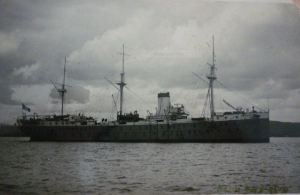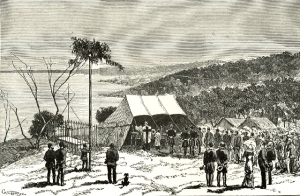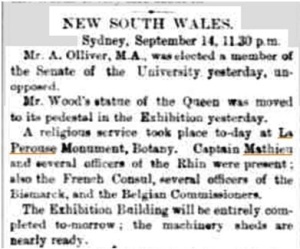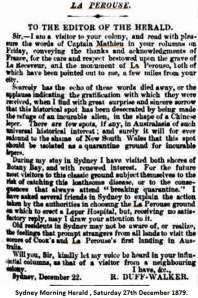1824 - La Coquille
March 1824 Corvette La Coquille under Commander Duperrey
1825 - Thetis and L’Esperance
Visit 26 August 1825 Commander Baron de Bougainville of the Frigate Thetis and Captain Du Campier of L’Esperance. Foundation stone laid 6 September 1825.
1838 – Venus
12 December 1828, Commander A Du Petit Thouars visited the monument in company wth J.H. Plunkett (Attorney General); C. Deas Thomson (Colonial Secretary), and Mr Therry (Assistant Public Prosecutor).
1879 - Rhin

 Plaque presented 14th September 1879
Plaque presented 14th September 1879
 Captain Adolphe François MATHIEU
Captain Adolphe François MATHIEU
Captain Mathieu was commander of the Rhin and the French Commisioner-General to the International Exhibition in Sydney.
(From Freeman Journal, September 1879): Australia and France. — On Thursday last week captain Mathieu and officers of the Frenchman-of-war Rhin, and the French Commissioners to tho International Exhibition, waited upon his Worship the Mayor of Sydney (Mr. C. J.Roberts), and the Aldermen of the city, at the Town Hall, for the purpose of returning the visit paid some days before on board the Rhin, and of presenting to the city a handsome Sevres vase, forwarded by the French Government as a souvenir of the interest which France takes in the Sydney International Exhibition and in New South Wales. The French flag was flying in front of the Town Hall throughout the day. The visitors having been received by the Mayor were introduced by him to the aldermen and the others present, and were then conducted into his’ Worship’s private room, where a light repast, elegantly laid, was in waiting. In proposing the toast of Captain Mathieu and his officers, the Mayor said, ‘ I am delighted to hear, as I am sure you all will be, that Captain Mathieu actually came to New South Wales to procure a partner for life.’ (Cheers and laughter.) We have been asked to state that this is not correct. Captain Mathieu’s first wife was an Australian lady, whom he married here some eighteen years ago. She is now dead, and he is married a second time to a French lady, who is still living at home in France. ………………………………….
Speech given at the luncheon by Captain Mathieu (speaking in French): “Mr. Mayor, a few days ago, when together with the aldermen and officers of the City Corporation, you were gracious enough to call on board the Rhin to give a welcome to her commander and officers, we felt the high honour you conferred upon us — we were sensible of this mark of courtesy and of sympathy. I come here to-day with my staff and the Commissioners sent from France to the International Exhibition, to tender the feelings of respect I entertain towards the first magistrate of this great city, the cradle of civilization, not only of New South Wales, but of the Australian colonies, (cheers). Although I number many old friends in Sydney, I am fully aware that your visit to the commander of the Rhin was not an honour conferred on me personally, but to the naval representative of a nation whoso feelings of affection for England are true and sincere —(cheers) — because they are based on a true appreciation of one another. (Cheers.) It shall be my duty to communicate to my Government the friendly relations which exist between the citizens and the French residents of Sydney ; and I feel sure that the French nation will echo the thanks I now beg you to accept. (Cheers.) For a long time the colonists of New South Wales ,their Excellencies the Governors, and the officers of the local Government, have given proofs of good feeling to the French. On many occasions, our consuls and the commanders of the ships of war have mentioned these to the French Government. (Cheers.) We know that for many years Australians have kept a religious watch over the mortal remains of tho followers of Laperouse —(cheers) — who died at Botany Bay. We are aware that to the citizens of Sydney we are indebted for the care of the monument erected on that spot to mark the record of that great French navigator. (Cheers.) On several occasions France has left souvenirs to some of your countrymen. I may mention amongst others my friend, Captain Mann, whom, despite the manifold duties devolving upon him when in charge of the great naval works at Cockatoo, yet found time to afford facilities to the officers in charge of vessels of war docked in that island.’ (Cheers.) On this occasion, on tho occasion of the great national gathering which is to be held in Sydney next month, the French nation wishes to give to the citizens of Sydney a proof of their great sympathy, and to this effect: “The Secretary of State, Minister for Fine Arts, has charged me, in the name of tho Republic of France, to offer to the capital of the Australian Colonies a vase from tho National manufactory of Serves. (Cheers.) This vase is called ‘ Vase de Remini.” I have much pleasure, Mr. Mayor, in handing you a copy of the dispatch which conveys to me the order to offer you this present, and I shall avail myself of a suitable opportunity to place it in your hands, (Loud cheers.)
Adolphe Mathieu was born on 6 April 1827 in Paris.
He was appointed midshipman on 16 August 1844; sub-lieutenant 1 October 1848, being then based in BREST. He was promoted lieutenant on 3 February 1855; commander on 7 March 1868, and captain on 29 January 1879. He retired in 1887 and, in 1888, he was appointed Director of the Orphans Establishment which position he filled until 1897.
He served on board the sloops COETLOGON (1860-1865) and MARCEAU (1866-1868). He was posted to New Caledonia from 1868-1870. In January 1879, he was appointed a member of the High Commission for Submarine Defences and, later in that year, he commanded the corvette THETIS at Toulon. In January 1881, he was posted to the port of BREST. In January 1883, he appointed to command the MESSAGER, the School for Submarine Defences, at ROCHEFORT. In January 1886, he was appointed to command the School for Stokers at BREST.
He was appointed chevalier of the Legion of Honour on 6 August 1858; officier on 27 December 1872; and commandeur 29 June 1886.
He also held the Colonial Medal with clasps Nouvelle-Calédonie, Algérie, and Iles de la Société.
Captain MATHIEU died in BREST on 7 September 1912.
RHIN (1854-1886)
This screw transport was built in Rochefort. Laid down in October 1854, it was launched on 31 August 1855, and was fitted out for the first time in November 1855. The engine, of 230 h.p. which was built by Creusot, was installed between April and July 1870.
The main dimensions of the vessel were: length: 71.90 metres; width: 12.90 metres; draught: 8 metres; displacement: 2916 tonnes. It carried two 14cm cannons as armament.
In 1855, the Rhin made several voyages from Toulon to the Crimea and the island of Milo. In 1859, during the war in Italy, it carried out numerous crossings between France, Italy and Algeria. In December 1859, it left for China and returned to Rochefort in September 1862. At the end of 1862, it set sail for Alexandria and, from there, for Toulon where some repairs were carried out and it received new boilers. In August 1863, it left Toulon for the South Seas and from there for the west coast of Mexico. During the night of 3 February 1864, in the harbor of Mazatlan, it was struck by a violent gust of wind which drove it on to the rocks of Trestin Island; due to the serious damage caused by being driven ashore, it was towed to San Francisco by the frigate Victoire. It made several voyages afterwards to Guaymas, Acapulco, Mazatlan, San Blas; it called into Panama in December 1866, Callao in January 1867 and Valparaiso in March. From there, it set off for Rio where it arrived on 3 May and left again on 9 May for Toulon where it arrived on 27 June 1867. It sent ashore its machinery and boilers and set course for Brest where it arrived on 15 April 1869. Here it was laid up, had a complete refit and received a spar‑deck, and the machinery and boilers from the Allier. In this refit, the sail plan was modified and set up in conformity with that approved on 25 August 1864 for the Meuse.
In January 1872, the Rhin set course for Toulon where it took on board convicts and passengers for New Caledonia. It left for this destination in February 1872, passing through the Suez Canal, and reached Noumea in May. It returned to Rochefort via Cape Horn, reaching port in September 1872. In December 1872, it left again for Toulon where it again took on board convicts for New Caledonia and departed for this destination in January 1873. Going via Dakar, it reached Noumea and then returned via Cape Horn to Brest where it was laid up in September 1873.
Fitted out on 2 August 1875, the Rhin left Brest on 1 September 1875 for Rochefort where it embarked convicts for New Caledonia. It set sail on 6 September 1875 and reached Noumea on 30 January 1876. It returned to Toulon via Cape Horn, reaching port on 24 October 1876, when it was laid up.
The Rhin was fitted out again in Toulon in 1879 to carry French products to the Sydney Exposition. The ship returned from Sydney, via Cape Horn, to Toulon where it was laid up in March 1880. It was fitted out for one last time at Toulon in March 1885 to carry out voyages between Madagascar and Reunion; the upper and lower gun-decks were fitted with sleeping berths and planks for sleeping bags with a view to transporting passengers. Condemned by Ministerial decision of 5 June 1886, this vessel was used as a collier and a station for torpedo-boats of the 1st Ocean Flotilla at Lézardrieux until 1910, when it was sold.
1884 - La Bruat


You must be logged in to post a comment.